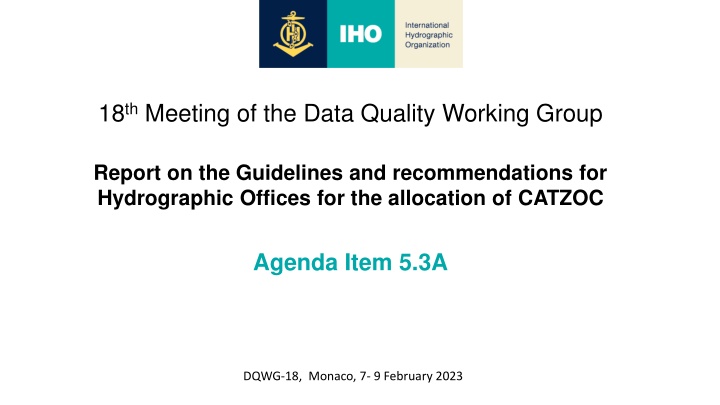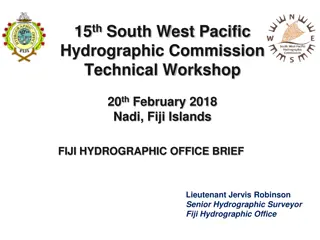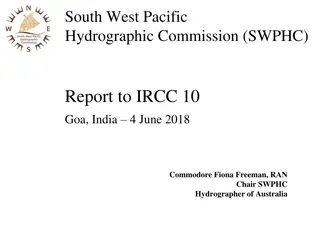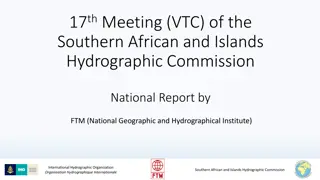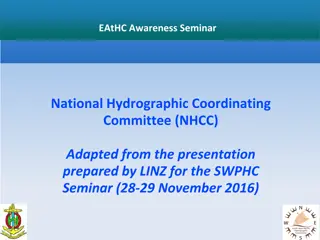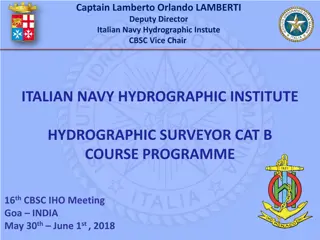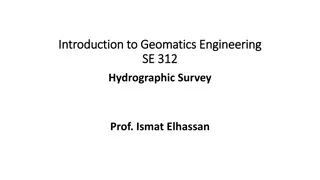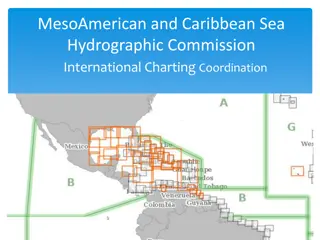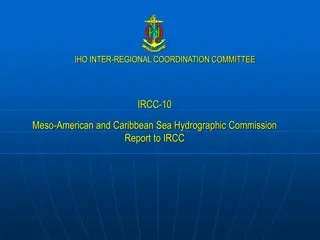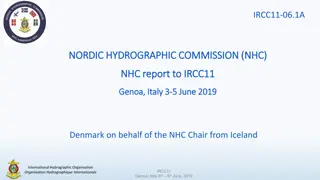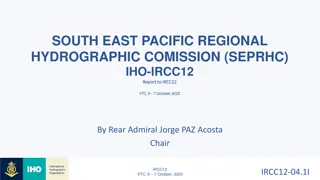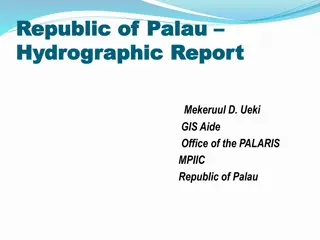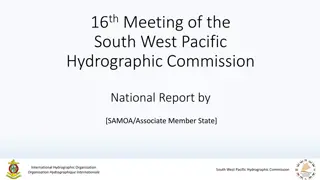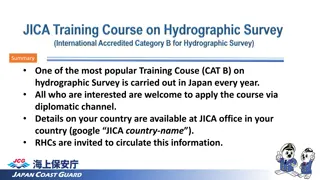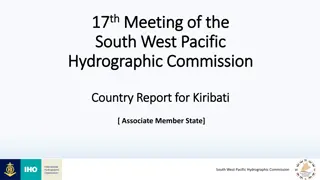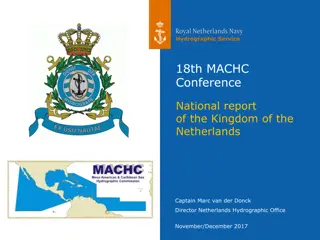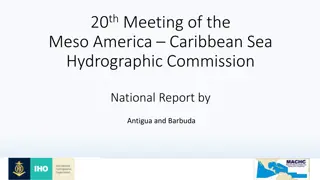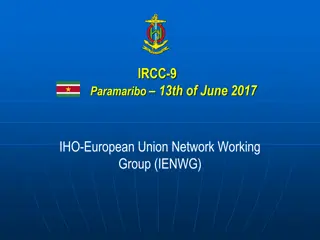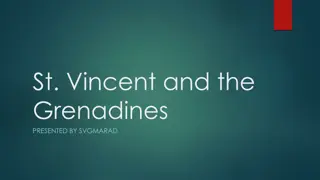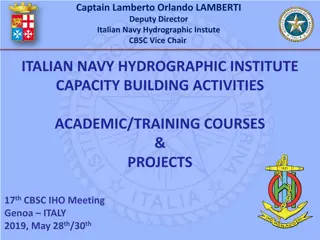Guidelines and Recommendations for Hydrographic Offices CATZOC Allocation
The report highlights guidelines for Hydrographic Offices to allocate CATZOC values based on minimum bathymetry standards, ZOC categories, and best practices from various national methodologies. It covers position accuracy, depth accuracy, and seafloor coverage criteria. The allocation is primarily based on parameters outlined in the ZOC table. HOs commonly use two methods to allocate CATZOC values - older survey-based rules and rules based on current data and survey methods.
Download Presentation

Please find below an Image/Link to download the presentation.
The content on the website is provided AS IS for your information and personal use only. It may not be sold, licensed, or shared on other websites without obtaining consent from the author.If you encounter any issues during the download, it is possible that the publisher has removed the file from their server.
You are allowed to download the files provided on this website for personal or commercial use, subject to the condition that they are used lawfully. All files are the property of their respective owners.
The content on the website is provided AS IS for your information and personal use only. It may not be sold, licensed, or shared on other websites without obtaining consent from the author.
E N D
Presentation Transcript
18thMeeting of the Data Quality Working Group Report on the Guidelines and recommendations for Hydrographic Offices for the allocation of CATZOC Agenda Item 5.3A DQWG-18, Monaco, 7- 9 February 2023
1. INTRODUCTION 1. INTRODUCTION Minimum Bathymetry Standards for Safety of Navigation Hydrographic Surveys defined by S-44 Criteria Order 2 Areas where a general description of the sea floor is considered adequate. Order 1b Order 1a Special Order Exclusive Order Areas where there is strict minimum underkeel clearance and manoeuvrability criteria Areas where underkeel clearance is not considered to be an issue for the type of surface shipping expected to transit the area. Areas where underkeel clearance is considered not to be critical but features of concern to surface shipping may exist. Areas where underkeel clearance is critical Area description (Generally) Depth THU 20 m +10% of depth 5 m+5% of depth 5 m+5% of depth [m]+ 2 m 1 m *Ba5, Bb2 *Ba8, Bb3 *Ba8, Bb3 [% of Depth] Depth TVU *Ba9 a = 0.25 m *Ba10 a = 1.0 m a = 0.5 m a = 0.5 m a = 0.15 m (a) [m] b = 0.023 b = 0.013 b = 0.013 b = 0.0075 b = 0.0075 and (b) *Bc7, Bd4 *Bc8, Bd6 *Bc8, Bd6 *Bc10, Bd8 *Bc12, Bd8 Cubic features > 2 m, in depths down to 40 m; 10% of depth beyond 40 m Feature Detection Cubic features > 1 m Cubic features > 0.5 m [m] or Not Specified Not Specified [% of Depth] *Be5, Bf3 beyond 40m *Be6 *Be9 Feature Search Recommended but Not Required Recommended but Not Required 100% 100% 200% [%] *Bg9 *Bg9 *Bg12 Bathymetric Coverage 5% 5% 100% 100% 200% [%] *Bh3 *Bh3 * Bh9 *Bh9 *Bh12
1. INTRODUCTION 1. INTRODUCTION ZOC Categories ZOC QoBD Position Accuracy Depth Accuracy Seafloor Coverage Full area search undertaken, significant seafloor features detected and depths measured A1 1 5m + 1% depth 0.50m + 1% depth Full area search undertaken. Significant seafloor features detected and depths measured A2 2 20 m 1.00 m + 2% depth Full area search not achieved; uncharted features hazardous to surface navigation are not expected but may exist. B 3 50 m 1.00 m + 2 % depth Full area search not achieved; depth anomalies may be expected. Full area search not achieved, large depth anomalies may be expected. C 4 500 m 2.00 m + 5% depth D 5 Worse than ZOC C Worse than ZOC C 6 Unassessed U Quality of data has yet to be assessed O Oceanic Oceanic areas with water depth greater than 200m Notes: More detailed information about CATZOC can be found in IHO Publication S-67.
1. INTRODUCTION 1. INTRODUCTION HO Best practice examples/National Methodologies Information regarding the national methodologies employed for the allocation of CATZOC values from survey data was collected from 12 hydrographic offices (Australia, Brazil, Denmark, Finland, France, India, Italy, Japan, Netherlands, Norway, United Kingdom, and United States of America). Analysis of the results demonstrated that HOs allocate CATZOC values principally based on the parameters described in the ZOC table included in S-57 Supplement No. 3 June 2014. Some HOs do not use all the ZOC categories and some employ a slightly modified version, e.g., in the case where CATZOC A1 and A2 are combined (e.g., Finland). However fundamentally all HOs that responded demonstrated a policy of allocating CATZOC values to indicate that particular data meets minimum criteria for position and depth accuracy and seafloor coverage in accordance with the ZOC table. To allocate CATZOC, HOs commonly use two methods: Older survey: the lack of metadata requires HOs to allocate CATZOC with rules based on the age or currentness of the data in conjunction with technical details of the methods used to conduct the survey. Recent survey: the decision of CATZOC value allocation is based on the parameters described in the ZOC table and more recently with the parameters associated with the various survey orders set out in S-44. After assignments, some HOs s may downgrade the CATZOC/QoBD values due to the passage of time, generalization, natural disasters, and the instability of bathymetry and so on, in order to ensure safety of navigation.
2. SURVEY 2. SURVEY ORDER ORDER CATZOC COMPARISON CATZOC COMPARISON S-44 and S-57/S-101 share the following concepts: 1.Horizontal accuracy (position) 2.Vertical accuracy (depth) 3.Completeness (full seafloor coverage and feature detection) Vertical Accuracy S-57/S-101 (ZOC) S-44 (Survey) ZOC Category ZOC Tolerance Survey Order Survey tolerance ((0.152+ (0.0075*d)2) A1 0.5m + 0.01*d Exclusive ((0.252+ (0.0075*d)2) A2 1.0m + 0.02*d Special ((0.52+ (0.013*d)2) B 1.0m + 0.02* d 1a Horizontal Accuracy ((0.52+ (0.013*d)2) C 2.0m + 0.05*d 1b S-57/S-101 (ZOC) S-44 (Survey) ((1.02+ (0.023*d)2) D > 2.0m + 0.05* d 2 ZOC Category ZOC Tolerance Survey Order Survey tolerance A1 5m + 0.05*d Exclusive 1m A2 20m Special 2m Feature Detection B 50m 1a 5m + 0.05*d S-57/S-101 (ZOC) S-44 (Survey) C 500m 1b 5m + 0.05*d ZOC Category A1 ZOC Requirement Detected (2m, or 0.1*d if d>40m) Detected (2m, or 0.1*d if d>40m) Features not expected but may exist Depth anomalies may be expected Large depth anomalies may be expected Survey Order Exclusive Survey Requirement cubic features > 0.5 meter cubic features > 1 meter cubic features > 2m, or 0.1*d if d>40m Not Specified D >500m 2 20m +0.1*d A2 Special Seafloor Coverage S-57/S-101 (ZOC) ZOC Requirement S-44 (Survey) Survey Requirement 200% 100% 100% B 1a ZOC Category A1 A2 B C D Survey Order Exclusive Special 1a 1b 2 Full Full C 1b Not required Not required Not required D 2 Not Specified 5% 5%
3. 3. CONVERSION MATRICES CONVERSION MATRICES When assigning a CATZOC value, HOs are recommended to follow the guideline herein. This consists of stages in the following order: Data assessment Significant features detected Least depth of significant features known Full seafloor coverage achieved Depth accuracy Positional accuracy Category of temporal variation (S-101 only)
3. 3. CONVERSION MATRICES CONVERSION MATRICES The following Tables illustrate the valid CATZOCs for the Survey Orders. It is noted that the assigned CATZOC is the result of combining the allowable CATZOC of these 7 stages/criteria. In the following matrices: green color is used to indicate that survey order meets the requirements of the respective CATZOC, e.g., the vertical uncertainty of Special Order meets the vertical accuracy criteria of all CATZOC (i.e., A1, A2, B, C, D). However, this valid relation does not mean appropriate. For example, the appropriate CATZOC for a special order survey is A1; CATZOC values of A2, B, C, and D are valid (i.e., can be assigned) but do not justify the high data quality of the original survey. Red color is used to indicate that the survey order requirements do not meet those of the respective CATZOC, thus assigning this ZOC category is not recommended. Orange color is used to indicate relations that are valid up to a specific water depth, while for depths greater than the cell value the Survey Order criteria do not meet that of CATZOC. For instance, the vertical accuracy of Survey Order 1a generally meets the CATZOC A1 but not for water depth greater than 145m. Lastly, grey color is used to indicate that Survey Order and CATZOC are not comparable (I.e., there are no explicitly defined requirements for CATZOCs U and O).
3. 3. CONVERSION MATRICES CONVERSION MATRICES Check 1: Data assessment Valid CATZOCs for the Survey Orders based on Data assessment If a CATZOC value is given U=unassessed then no further checks are required.
3. 3. CONVERSION MATRICES CONVERSION MATRICES Check 2: Significant features detected Valid CATZOCs for the Survey Orders based on Significant features detected
3. 3. CONVERSION MATRICES CONVERSION MATRICES Check 3: Least depth of significant features known Valid CATZOCs for the Survey Orders based on Least depth of significant features known
3. 3. CONVERSION MATRICES CONVERSION MATRICES Check 4: Full seafloor coverage achieved Valid CATZOCs for the Survey Orders based on Full seafloor coverage achieved
3. 3. CONVERSION MATRICES CONVERSION MATRICES Check 5: Depth accuracy Valid CATZOCs for the Survey Orders based on Depth accuracy
3. 3. CONVERSION MATRICES CONVERSION MATRICES Check 6: Positional accuracy Valid CATZOCs for the Survey Orders based on Positional accuracy
3. 3. CONVERSION MATRICES CONVERSION MATRICES Check 7: Least depth of significant features known This is regardless of the S-44 classification of the survey. In S-57 and when upgrading to S-101, the default value of this attribute is unlikely to change and thus not affecting the outcome of this checking process. HO s are however requested to assign the correct value to this attribute when making the upgrade to S-101.
3. 3. CONVERSION MATRICES CONVERSION MATRICES When the above steps are combined we get the following table that illustrates the minimum achieved Survey Order for each CATZOC. minimum achieved Survey Order for each CATZOC
3. 3. CONVERSION MATRICES CONVERSION MATRICES Summary of the valid CATZOCs for the Survey Orders Notes: It is pointed out that the presented matrices represent a direct comparison between CATZOC/QoBD and S-44 Survey Orders minimum standards, however, hydrographic offices may follow different practices in particular cases.
4. 4. NEXT STEP NEXT STEP The Section 7.6 of S-44 Ed 6.1.0 introduced a new specification matrix that provides a range of selectable criteria for bathymetric parameters and other data types collected, reported, and delivered as part of a hydrographic survey. A spreadsheet that translates the new S-44 matrix parameters into CATZOC is in development. The scope of the spreadsheet is to help HOs in assigning CATZOC with producing an aggregated CATZOC value for the input survey parameters.
ACTION REQUIRED OF DQWG The DQWG is invited to: a. Note the information provided; b. Endorse the document and submit it to HSSC 15 for approval; c. Continue the work and update the document.
